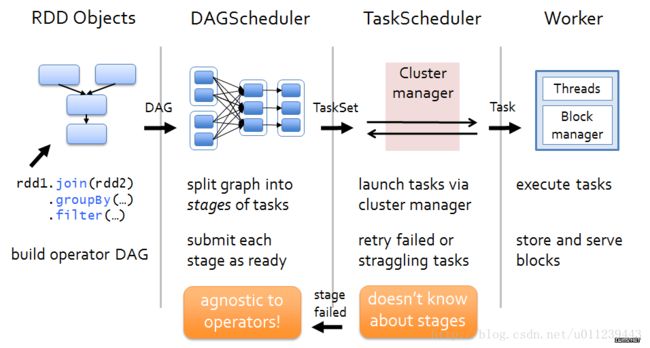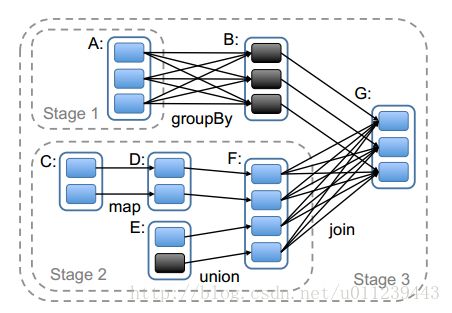上一篇《深入理解Spark 2.0 (一):RDD实现及源码分析 》的5.2 Spark任务调度器我们省略过去了,这篇我们就来讲讲Spark的调度器。
概述
上一篇《深入理解Spark(一):RDD实现及源码分析 》提到:
定义RDD之后,程序员就可以在动作(注:即action操作)中使用RDD了。动作是向应用程序返回值,或向存储系统导出数据的那些操作,例如,count(返回RDD中的元素个数),collect(返回元素本身),save(将RDD输出到存储系统)。在Spark中,只有在动作第一次使用RDD时,才会计算RDD(即延迟计算)。这样在构建RDD的时候,运行时通过管道的方式传输多个转换。
一次action操作会触发RDD的延迟计算,我们把这样的一次计算称作一个Job。我们还提到了窄依赖和宽依赖的概念:
窄依赖指的是:每个parent RDD 的 partition 最多被 child RDD的一个partition使用
宽依赖指的是:每个parent RDD 的 partition 被多个 child RDD的partition使用
窄依赖每个child RDD 的partition的生成操作都是可以并行的,而宽依赖则需要所有的parent partition shuffle结果得到后再进行。
由于在RDD的一系类转换中,若其中一些连续的转换都是窄依赖,那么它们是可以并行的,而有宽依赖则不行。所有,Spark将宽依赖为划分界限,将Job换分为多个Stage。而一个Stage里面的转换任务,我们可以把它抽象成TaskSet。一个TaskSet中有很多个Task,它们的转换操作都是相同的,不同只是操作的对象是对数据集中的不同子数据集。
接下来,Spark就可以提交这些任务了。但是,如何对这些任务进行调度和资源分配呢?如何通知worker去执行这些任务呢?接下来,我们会一一讲解。
根据以上两个阶段,我们会来详细介绍两个Scheduler,一个是DAGScheduler,另外一个是TaskScheduler。
我们先来看一来在SparkContext中是如何创建它们的:
val (sched, ts) = SparkContext.createTaskScheduler(this, master, deployMode)
_schedulerBackend = sched
_taskScheduler = ts
_dagScheduler = new DAGScheduler(this)
可以看到,我们是先用函数createTaskScheduler创建了taskScheduler,再new了一个DAGScheduler。这个顺序可以改变吗?答案是否定的,我们看下DAGScheduler类就知道了:
class DAGScheduler(
private[scheduler] val sc: SparkContext,
private[scheduler] val taskScheduler: TaskScheduler,
listenerBus: LiveListenerBus,
mapOutputTracker: MapOutputTrackerMaster,
blockManagerMaster: BlockManagerMaster,
env: SparkEnv,
clock: Clock = new SystemClock())
extends Logging {
def this(sc: SparkContext, taskScheduler: TaskScheduler) = {
this(
sc,
taskScheduler,
sc.listenerBus,
sc.env.mapOutputTracker.asInstanceOf[MapOutputTrackerMaster],
sc.env.blockManager.master,
sc.env)
}
def this(sc: SparkContext) = this(sc, sc.taskScheduler)
***
}
SparkContext中创建的TaskScheduler,会传入DAGScheduler赋值给它的成员变量,再DAG阶段结束后,使用它进行下一步对任务调度等的操作。
提交Job
调用栈如下:
- rdd.count
- SparkContext.runJob
- DAGScheduler.runJob
- DAGScheduler.submitJob
- DAGSchedulerEventProcessLoop.doOnReceive
- DAGScheduler.handleJobSubmitted
- DAGSchedulerEventProcessLoop.doOnReceive
- DAGScheduler.submitJob
- DAGScheduler.runJob
接下来,我们来逐个深入:
rdd.count
RDD的一些action操作都会触发SparkContext的runJob函数,如count()
def count(): Long = sc.runJob(this, Utils.getIteratorSize _).sum
SparkContext.runJob
SparkContext的runJob会触发 DAGScheduler的runJob:
def runJob[T, U: ClassTag](
rdd: RDD[T],
func: (TaskContext, Iterator[T]) => U,
partitions: Seq[Int],
resultHandler: (Int, U) => Unit): Unit = {
if (stopped.get()) {
throw new IllegalStateException("SparkContext has been shutdown")
}
val callSite = getCallSite
val cleanedFunc = clean(func)
logInfo("Starting job: " + callSite.shortForm)
if (conf.getBoolean("spark.logLineage", false)) {
logInfo("RDD's recursive dependencies:\n" + rdd.toDebugString)
}
dagScheduler.runJob(rdd, cleanedFunc, partitions, callSite, resultHandler, localProperties.get)
progressBar.foreach(_.finishAll())
rdd.doCheckpoint()
}
这里的rdd.doCheckpoint()并不是对自己Checkpoint,而是递归的回溯parent rdd 检查checkpointData是否被定义了,若定义了就将该rdd Checkpoint:
private[spark] def doCheckpoint(): Unit = {
RDDOperationScope.withScope(sc, "checkpoint", allowNesting = false, ignoreParent = true) {
if (!doCheckpointCalled) {
doCheckpointCalled = true
if (checkpointData.isDefined) {
if (checkpointAllMarkedAncestors) {
//若想要把checkpointData定义过的RDD的parents也进行checkpoint的话,
//那么我们需要先对parents checkpoint。
//这是因为,如果RDD把自己checkpoint了,
//那么它就将lineage中它的parents给切除了。
dependencies.foreach(_.rdd.doCheckpoint())
}
checkpointData.get.checkpoint()
} else {
dependencies.foreach(_.rdd.doCheckpoint())
}
}
}
}
具体的checkpoint实现可见上一篇博文。
DAGScheduler.runJob
DAGScheduler的runJob会触发DAGScheduler的submitJob:
/**
* 参数介绍:
* @param rdd: 执行任务的目标TDD
* @param func: 在RDD的分区上所执行的函数
* @param partitions: 需要执行的分区集合;有些job并不会对RDD的所有分区都进行计算的,比如说first()
* @param callSite:用户程序的调用点
* @param resultHandler:回调结果
* @param properties:关于这个job的调度器特征,比如说公平调度的pool名字,这个会在后续讲到
*/
def runJob[T, U](
rdd: RDD[T],
func: (TaskContext, Iterator[T]) => U,
partitions: Seq[Int],
callSite: CallSite,
resultHandler: (Int, U) => Unit,
properties: Properties): Unit = {
val start = System.nanoTime
val waiter = submitJob(rdd, func, partitions, callSite, resultHandler, properties)
***
waiter.completionFuture.value.get match {
case scala.util.Success(_) =>
logInfo("Job %d finished: %s, took %f s".format
(waiter.jobId, callSite.shortForm, (System.nanoTime - start) / 1e9))
case scala.util.Failure(exception) =>
logInfo("Job %d failed: %s, took %f s".format
(waiter.jobId, callSite.shortForm, (System.nanoTime - start) / 1e9))
val callerStackTrace = Thread.currentThread().getStackTrace.tail
exception.setStackTrace(exception.getStackTrace ++ callerStackTrace)
throw exception
}
}
DAGScheduler.submitJob
我们接下来看看submitJob里面做了什么:
def submitJob[T, U](
rdd: RDD[T],
func: (TaskContext, Iterator[T]) => U,
partitions: Seq[Int],
callSite: CallSite,
resultHandler: (Int, U) => Unit,
properties: Properties): JobWaiter[U] = {
// 确认没在不存在的partition上执行任务
val maxPartitions = rdd.partitions.length
partitions.find(p => p >= maxPartitions || p < 0).foreach { p =>
throw new IllegalArgumentException(
"Attempting to access a non-existent partition: " + p + ". " +
"Total number of partitions: " + maxPartitions)
}
//递增得到jobId
val jobId = nextJobId.getAndIncrement()
if (partitions.size == 0) {
//若Job没对任何一个partition执行任务,
//则立即返回
return new JobWaiter[U](this, jobId, 0, resultHandler)
}
assert(partitions.size > 0)
val func2 = func.asInstanceOf[(TaskContext, Iterator[_]) => _]
val waiter = new JobWaiter(this, jobId, partitions.size, resultHandler)
eventProcessLoop.post(JobSubmitted(
jobId, rdd, func2, partitions.toArray, callSite, waiter,
SerializationUtils.clone(properties)))
waiter
}
DAGSchedulerEventProcessLoop.doOnReceive
eventProcessLoop是一个DAGSchedulerEventProcessLoop类对象,即一个DAG调度事件处理的监听。eventProcessLoop中调用doOnReceive来进行监听
private def doOnReceive(event: DAGSchedulerEvent): Unit = event match {
//当事件为JobSubmitted时,
//会调用DAGScheduler.handleJobSubmitted
case JobSubmitted(jobId, rdd, func, partitions, callSite, listener, properties) =>
dagScheduler.handleJobSubmitted(jobId, rdd, func, partitions, callSite, listener, properties)
***
}
DAGScheduler.handleJobSubmitted
自此Job的提交就完成了:
private[scheduler] def handleJobSubmitted(jobId: Int,
finalRDD: RDD[_],
func: (TaskContext, Iterator[_]) => _,
partitions: Array[Int],
callSite: CallSite,
listener: JobListener,
properties: Properties) {
var finalStage: ResultStage = null
try {
finalStage = newResultStage(finalRDD, func, partitions, jobId, callSite)
} catch {
case e: Exception =>
logWarning("Creating new stage failed due to exception - job: " + jobId, e)
listener.jobFailed(e)
return
}
val job = new ActiveJob(jobId, finalStage, callSite, listener, properties)
clearCacheLocs()
logInfo("Got job %s (%s) with %d output partitions".format(
job.jobId, callSite.shortForm, partitions.length))
logInfo("Final stage: " + finalStage + " (" + finalStage.name + ")")
logInfo("Parents of final stage: " + finalStage.parents)
logInfo("Missing parents: " + getMissingParentStages(finalStage))
val jobSubmissionTime = clock.getTimeMillis()
jobIdToActiveJob(jobId) = job
activeJobs += job
finalStage.setActiveJob(job)
val stageIds = jobIdToStageIds(jobId).toArray
val stageInfos = stageIds.flatMap(id => stageIdToStage.get(id).map(_.latestInfo))
listenerBus.post(
SparkListenerJobStart(job.jobId, jobSubmissionTime, stageInfos, properties))
submitStage(finalStage)
submitWaitingStages()
}
接下来我们来看看handleJobSubmitted中的newResultStage,一个非常有趣的划分Stage过程。
划分Stage
如我们之前提到的:Spark将宽依赖为划分界限,将Job换分为多个Stage。调用栈为:
- DAGScheduler.newResultStage
- DAGScheduler.getParentStagesAndId
- DAGScheduler.getParentStages
- DAGScheduler.getShuffleMapStage
- DAGScheduler.getAncestorShuffleDependencies
- DAGScheduler.newOrUsedShuffleStage
- DAGScheduler.newShuffleMapStage
接下来,我们来逐个深入:
DAGScheduler.newResultStage
Spark的Stage调用是从最后一个RDD所在的Stage,ResultStage开始划分的,这里即为G所在的Stage。但是在生成这个Stage之前会生成它的parent Stage,就这样递归的把parent Stage都先生成了。
private def newResultStage(
rdd: RDD[_],
func: (TaskContext, Iterator[_]) => _,
partitions: Array[Int],
jobId: Int,
callSite: CallSite): ResultStage = {
val (parentStages: List[Stage], id: Int) = getParentStagesAndId(rdd, jobId)
val stage = new ResultStage(id, rdd, func, partitions, parentStages, jobId, callSite)
stageIdToStage(id) = stage
updateJobIdStageIdMaps(jobId, stage)
stage
}
DAGScheduler.getParentStagesAndId
getParentStagesAndId中得到了ParentStages以及其StageId:
private def getParentStagesAndId(rdd: RDD[_], firstJobId: Int): (List[Stage], Int) = {
val parentStages = getParentStages(rdd, firstJobId)
val id = nextStageId.getAndIncrement()
(parentStages, id)
}
DAGScheduler.getParentStages
我们再来深入看看getParentStages做了什么:
private def getParentStages(rdd: RDD[_], firstJobId: Int): List[Stage] = {
//将存储ParentStages
val parents = new HashSet[Stage]
//存储已将访问过了的RDD
val visited = new HashSet[RDD[_]]
// 存储需要被处理的RDD
val waitingForVisit = new Stack[RDD[_]]
def visit(r: RDD[_]) {
if (!visited(r)) {
//加入访问集合
visited += r
//遍历该RDD所有的依赖
for (dep <- r.dependencies) {
dep match {
//若是宽依赖则生成新的Stage
case shufDep: ShuffleDependency[_, _, _] =>
parents += getShuffleMapStage(shufDep, firstJobId)
//若是窄依赖则加入Stack,等待处理
case _ =>
waitingForVisit.push(dep.rdd)
}
}
}
}
//在Stack中加入最后一个RDD
waitingForVisit.push(rdd)
//广度优先遍历
while (waitingForVisit.nonEmpty) {
visit(waitingForVisit.pop())
}
//返回ParentStages List
parents.toList
}
其实getParentStages使用的就是广度优先遍历的算法,若知道这点也容易理解了。虽然现在Stage并没有生成,但是我们可以看到划分策略是:广度遍历方式的划分parent RDD 的Stage。
若parent RDD 和 child RDD 为窄依赖,则将parent RDD 纳入 child RDD 所在的Stage中。如图,B被纳入了Stage3中。
若parent RDD 和 child RDD 为宽依赖,则parent RDD将纳入一新的Stage中。如图,F被纳入了Stage2中。
DAGScheduler.getShuffleMapStage
下面我们来看下getShuffleMapStage是如何生成新的Stage的。
首先shuffleToMapStage中保存了关于Stage的HashMap
private[scheduler] val shuffleToMapStage = new HashMap[Int, ShuffleMapStage]
getShuffleMapStage会先去根据shuffleId去查找shuffleToMapStage
private def getShuffleMapStage(
shuffleDep: ShuffleDependency[_, _, _],
firstJobId: Int): ShuffleMapStage = {
shuffleToMapStage.get(shuffleDep.shuffleId) match {
//若找到则直接返回
case Some(stage) => stage
case None =>
// 检查这个Stage的Parent Stage是否生成
// 若没有,则生成它们
getAncestorShuffleDependencies(shuffleDep.rdd).foreach { dep =>
if (!shuffleToMapStage.contains(dep.shuffleId)) {
shuffleToMapStage(dep.shuffleId) = newOrUsedShuffleStage(dep, firstJobId)
}
}
// 生成新的Stage
val stage = newOrUsedShuffleStage(shuffleDep, firstJobId)
//将新的Stage 加入到 HashMap
shuffleToMapStage(shuffleDep.shuffleId) = stage
//返回新的Stage
stage
}
}
可以发现这部分的代码和上述的newResultStage部分很像,所以可以看成一种递归的方法。
DAGScheduler.getAncestorShuffleDependencies
我们再来看下getAncestorShuffleDependencies,可想而知,它应该会和newResultStage中的getParentStages会非常类似:
private def getAncestorShuffleDependencies(rdd: RDD[_]): Stack[ShuffleDependency[_, _, _]] = {
val parents = new Stack[ShuffleDependency[_, _, _]]
val visited = new HashSet[RDD[_]]
val waitingForVisit = new Stack[RDD[_]]
def visit(r: RDD[_]) {
if (!visited(r)) {
visited += r
for (dep <- r.dependencies) {
dep match {
case shufDep: ShuffleDependency[_, _, _] =>
if (!shuffleToMapStage.contains(shufDep.shuffleId)) {
parents.push(shufDep)
}
case _ =>
}
waitingForVisit.push(dep.rdd)
}
}
}
waitingForVisit.push(rdd)
while (waitingForVisit.nonEmpty) {
visit(waitingForVisit.pop())
}
parents
}
可以看到的确和newResultStage中的getParentStages会非常类似,不同的是这里会先判断shuffleToMapStage是否存在这个Stage,不存在的话会push到parents这个Stack,最会返回给上述的getShuffleMapStage,调用newOrUsedShuffleStage生成新的Stage。
DAGScheduler.newOrUsedShuffleStage
那现在就来看newOrUsedShuffleStage是如何生成新的Stage的。
首先ShuffleMapTask的计算结果(其实是计算结果数据所在的位置、大小等元数据信息)都会传给Driver的mapOutputTracker。所以需要先判断Stage是否已经被计算过:
private def newOrUsedShuffleStage(
shuffleDep: ShuffleDependency[_, _, _],
firstJobId: Int): ShuffleMapStage = {
val rdd = shuffleDep.rdd
val numTasks = rdd.partitions.length
//生成新的Stage
val stage = newShuffleMapStage(rdd, numTasks, shuffleDep, firstJobId, rdd.creationSite)
//判断Stage是否已经被计算过
//若计算过,则把结果复制到新的stage
if (mapOutputTracker.containsShuffle(shuffleDep.shuffleId)) {
val serLocs = mapOutputTracker.getSerializedMapOutputStatuses(shuffleDep.shuffleId)
val locs = MapOutputTracker.deserializeMapStatuses(serLocs)
(0 until locs.length).foreach { i =>
if (locs(i) ne null) {
stage.addOutputLoc(i, locs(i))
}
}
} else {
logInfo("Registering RDD " + rdd.id + " (" + rdd.getCreationSite + ")")
//如果没计算过,就在注册mapOutputTracker Stage
//为存储元数据占位
mapOutputTracker.registerShuffle(shuffleDep.shuffleId, rdd.partitions.length)
}
stage
}
DAGScheduler.newShuffleMapStage
递归就发生在newShuffleMapStage,它的实现和最一开始的newResultStage类似,也是先getParentStagesAndId,然后生成一个ShuffleMapStage:
private def newShuffleMapStage(
rdd: RDD[_],
numTasks: Int,
shuffleDep: ShuffleDependency[_, _, _],
firstJobId: Int,
callSite: CallSite): ShuffleMapStage = {
val (parentStages: List[Stage], id: Int) = getParentStagesAndId(rdd, firstJobId)
val stage: ShuffleMapStage = new ShuffleMapStage(id, rdd, numTasks, parentStages,
firstJobId, callSite, shuffleDep)
stageIdToStage(id) = stage
updateJobIdStageIdMaps(firstJobId, stage)
stage
}
回顾
到此,Stage划分过程就结束了。我们在根据一开始的图,举例回顾下:
- 首先,我们想
newResultStageRDD_G所在的Stage3 - 但在
new Stage之前会调用getParentStagesAndId -
getParentStagesAndId中又会调用getParentStages,来广度优先的遍历RDD_G所依赖的RDD。如果是窄依赖,就纳入G所在的Stage3,如RDD_B就纳入了Stage3 - 若过是宽依赖,我们这里以
RDD_F为例(与RDD_A处理过程相同)。我们就会调用getShuffleMapStage,来判断RDD_F所在的Stage2是否已经生成了,如果生成了就直接返回。 - 若还没生成,我们先调用
getAncestorShuffleDependencies。getAncestorShuffleDependencies类似于getParentStages,也是用广度优先的遍历RDD_F所依赖的RDD。如果是窄依赖,如RDD_C、RDD_D和RDD_E,都被纳入了F所在的Stage2。但是假设RDD_E有个parent RDD ``RDD_H,RDD_H和RDD_E之间是宽依赖,那么该怎么办呢?我们会先判断RDD_H所在的Stage是否已经生成。若还没生成,我们把它put到一个parents Stack 中,最后返回。 - 对于那些返回的还没生成的Stage我们会调用
newOrUsedShuffleStage -
newOrUsedShuffleStage会调用newShuffleMapStage,来生成新的Stage。而newShuffleMapStage的实现类似于newResultStage。这样我们就可以递归下去,使得每个Stage所依赖的Stage都已经生成了,再来生成这个的Stage。如这里,会将RDD_H所在的Stage生成了,然后在再生成Stage2。 -
newOrUsedShuffleStage生成新的Stage后,会判断Stage是否被计算过。若已经被计算过,就从mapOutPutTracker中复制计算结果。若没计算过,则向mapOutPutTracker注册占位。 - 最后,回到
newResultStage中,new ResultStage,这里即生成了Stage3。至此,Stage划分过程就结束了。
生成任务
调用栈如下:
- DAGScheduler.handleJobSubmitted
- DAGScheduler.submitStage
- DAGScheduler.getMissingParentStages
- DAGScheduler.submitMissingTasks
DAGScheduler.handleJobSubmitted
我们再回过头来看“提交Job"的最后一步handleJobSubmitted:
private[scheduler] def handleJobSubmitted(jobId: Int,
finalRDD: RDD[_],
func: (TaskContext, Iterator[_]) => _,
partitions: Array[Int],
callSite: CallSite,
listener: JobListener,
properties: Properties) {
var finalStage: ResultStage = null
try {
finalStage = newResultStage(finalRDD, func, partitions, jobId, callSite)
} catch {
case e: Exception =>
logWarning("Creating new stage failed due to exception - job: " + jobId, e)
listener.jobFailed(e)
return
}
***
}
在"划分Stage"中我们已经深入的讲解了finalStage的生成:
finalStage = newResultStage(finalRDD, func, partitions, jobId, callSite)
接下来,我们继续往下看handleJobSubmitted的代码:
//生成新的job
val job = new ActiveJob(jobId, finalStage, callSite, listener, properties)
clearCacheLocs()
logInfo("Got job %s (%s) with %d output partitions".format(
job.jobId, callSite.shortForm, partitions.length))
logInfo("Final stage: " + finalStage + " (" + finalStage.name + ")")
logInfo("Parents of final stage: " + finalStage.parents)
logInfo("Missing parents: " + getMissingParentStages(finalStage))
//得到job提交的时间
val jobSubmissionTime = clock.getTimeMillis()
//得到job id
jobIdToActiveJob(jobId) = job
//添加到activeJobs HashSet
activeJobs += job
//将finalStage甚至ActiveJob为该job
finalStage.setActiveJob(job)
//得到stage 的id 信息
val stageIds = jobIdToStageIds(jobId).toArray
val stageInfos = stageIds.flatMap(id => stageIdToStage.get(id).map(_.latestInfo))
//监听
listenerBus.post(
SparkListenerJobStart(job.jobId, jobSubmissionTime, stageInfos, properties))
//提交
submitStage(finalStage)
//等待
submitWaitingStages()
DAGScheduler.submitStage
接下来我们来看Stage是如何提交的。我们需要找到哪些parent Stage缺失,然后我们先运行生成这些Stage。这是一个深度优先遍历的过程:
private def submitStage(stage: Stage) {
val jobId = activeJobForStage(stage)
if (jobId.isDefined) {
logDebug("submitStage(" + stage + ")")
if (!waitingStages(stage) && !runningStages(stage) && !failedStages(stage)) {
//得到缺失的Parent Stage
val missing = getMissingParentStages(stage).sortBy(_.id)
logDebug("missing: " + missing)
if (missing.isEmpty) {
logInfo("Submitting " + stage + " (" + stage.rdd + "), which has no missing parents")
//如果没有缺失的Parent Stage,
//那么代表着该Stage可以运行了
//submitMissingTasks会完成DAGScheduler最后的工作,
//向TaskScheduler 提交 Task
submitMissingTasks(stage, jobId.get)
} else {
//深度优先遍历
for (parent <- missing) {
submitStage(parent)
}
waitingStages += stage
}
}
} else {
abortStage(stage, "No active job for stage " + stage.id, None)
}
}
DAGScheduler.getMissingParentStages
getMissingParentStages类似于getParentStages,也是使用广度优先遍历:
private def getMissingParentStages(stage: Stage): List[Stage] = {
val missing = new HashSet[Stage]
val visited = new HashSet[RDD[_]]
val waitingForVisit = new Stack[RDD[_]]
def visit(rdd: RDD[_]) {
if (!visited(rdd)) {
visited += rdd
val rddHasUncachedPartitions = getCacheLocs(rdd).contains(Nil)
if (rddHasUncachedPartitions) {
for (dep <- rdd.dependencies) {
dep match {
//若是宽依赖 并且 不可用 ,
//则加入 missing HashSet
case shufDep: ShuffleDependency[_, _, _] =>
val mapStage = getShuffleMapStage(shufDep, stage.firstJobId)
if (!mapStage.isAvailable) {
missing += mapStage
}
//若是窄依赖
//则加入等待访问的 HashSet
case narrowDep: NarrowDependency[_] =>
waitingForVisit.push(narrowDep.rdd)
}
}
}
}
}
waitingForVisit.push(stage.rdd)
while (waitingForVisit.nonEmpty) {
visit(waitingForVisit.pop())
}
missing.toList
}
DAGScheduler.submitMissingTasks
最后,我们来看下DAGScheduler最后的工作,提交Task:
private def submitMissingTasks(stage: Stage, jobId: Int) {
logDebug("submitMissingTasks(" + stage + ")")
// pendingPartitions 是 HashSet[Int]
//存储待处理的Task
stage.pendingPartitions.clear()
// 找出还未就算的Partition
val partitionsToCompute: Seq[Int] = stage.findMissingPartitions()
//从一个ActiveJob中得到关于这个Stage的
//调度池,job组描述等信息
val properties = jobIdToActiveJob(jobId).properties
// runningStages 是 HashSet[Stage]
//将当前Stage加入到运行中Stage集合
runningStages += stage
stage match {
case s: ShuffleMapStage =>
outputCommitCoordinator.stageStart(stage = s.id, maxPartitionId = s.numPartitions - 1)
case s: ResultStage =>
outputCommitCoordinator.stageStart(
stage = s.id, maxPartitionId = s.rdd.partitions.length - 1)
}
val taskIdToLocations: Map[Int, Seq[TaskLocation]] = try {
stage match {
case s: ShuffleMapStage =>
partitionsToCompute.map { id => (id, getPreferredLocs(stage.rdd, id))}.toMap
case s: ResultStage =>
partitionsToCompute.map { id =>
val p = s.partitions(id)
(id, getPreferredLocs(stage.rdd, p))
}.toMap
}
} catch {
case NonFatal(e) =>
stage.makeNewStageAttempt(partitionsToCompute.size)
listenerBus.post(SparkListenerStageSubmitted(stage.latestInfo, properties))
abortStage(stage, s"Task creation failed: $e\n${Utils.exceptionString(e)}", Some(e))
runningStages -= stage
return
}
stage.makeNewStageAttempt(partitionsToCompute.size, taskIdToLocations.values.toSeq)
//向listenerBus发送SparkListenerStageSubmitted事件
listenerBus.post(SparkListenerStageSubmitted(stage.latestInfo, properties))
var taskBinary: Broadcast[Array[Byte]] = null
try {
//对于最后一个Stage的Task,
//序列化并广播(rdd, func)。
//若是其他的Stage的Task,
//序列化并广播(rdd, shuffleDep)
val taskBinaryBytes: Array[Byte] = stage match {
case stage: ShuffleMapStage =>
JavaUtils.bufferToArray(
closureSerializer.serialize((stage.rdd, stage.shuffleDep): AnyRef))
case stage: ResultStage =>
JavaUtils.bufferToArray(closureSerializer.serialize((stage.rdd, stage.func): AnyRef))
}
taskBinary = sc.broadcast(taskBinaryBytes)
} catch {
//若序列化失败,停止这个stage
case e: NotSerializableException =>
abortStage(stage, "Task not serializable: " + e.toString, Some(e))
runningStages -= stage
// 停止执行
return
case NonFatal(e) =>
abortStage(stage, s"Task serialization failed: $e\n${Utils.exceptionString(e)}", Some(e))
runningStages -= stage
return
}
val tasks: Seq[Task[_]] = try {
//对于最后一个Stage的Task,
//则创建ResultTask。
//若是其他的Stage的Task,
//则创建ShuffleMapTask。
stage match {
case stage: ShuffleMapStage =>
partitionsToCompute.map { id =>
val locs = taskIdToLocations(id)
val part = stage.rdd.partitions(id)
new ShuffleMapTask(stage.id, stage.latestInfo.attemptId,
taskBinary, part, locs, stage.latestInfo.taskMetrics, properties, Option(jobId),
Option(sc.applicationId), sc.applicationAttemptId)
}
case stage: ResultStage =>
partitionsToCompute.map { id =>
val p: Int = stage.partitions(id)
val part = stage.rdd.partitions(p)
val locs = taskIdToLocations(id)
new ResultTask(stage.id, stage.latestInfo.attemptId,
taskBinary, part, locs, id, properties, stage.latestInfo.taskMetrics,
Option(jobId), Option(sc.applicationId), sc.applicationAttemptId)
}
}
} catch {
case NonFatal(e) =>
abortStage(stage, s"Task creation failed: $e\n${Utils.exceptionString(e)}", Some(e))
runningStages -= stage
return
}
if (tasks.size > 0) {
logInfo("Submitting " + tasks.size + " missing tasks from " + stage + " (" + stage.rdd + ")")
stage.pendingPartitions ++= tasks.map(_.partitionId)
logDebug("New pending partitions: " + stage.pendingPartitions)
//创建TaskSet并提交
taskScheduler.submitTasks(new TaskSet(
tasks.toArray, stage.id, stage.latestInfo.attemptId, jobId, properties))
stage.latestInfo.submissionTime = Some(clock.getTimeMillis())
} else {
markStageAsFinished(stage, None)
val debugString = stage match {
case stage: ShuffleMapStage =>
s"Stage ${stage} is actually done; " +
s"(available: ${stage.isAvailable}," +
s"available outputs: ${stage.numAvailableOutputs}," +
s"partitions: ${stage.numPartitions})"
case stage : ResultStage =>
s"Stage ${stage} is actually done; (partitions: ${stage.numPartitions})"
}
logDebug(debugString)
submitWaitingChildStages(stage)
}
}
TaskSet保存了Stage包含的一组完全相同的Task,每个Task的处理逻辑完全相同,不同的是处理的数据,每个Task负责一个Partition。
至此,DAGScheduler就完成了它的任务了。接下来一篇博文,我们会从上述代码中的:
taskScheduler.submitTasks(new TaskSet(
tasks.toArray, stage.id, stage.latestInfo.attemptId, jobId, properties))
开始讲起,深入理解TaskScheduler的工作过程。


